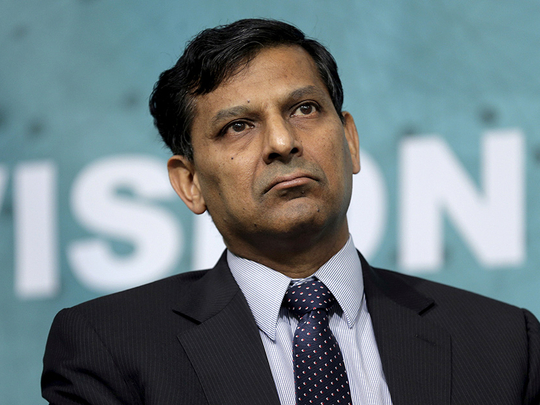
Dubai: Amid media frenzy on the Reserve Bank of India’s (RBI) governor Raghuram Rajan opting out of a second term, leaving behind the unfinished business of cleaning up the balance sheets of banks, there is some good news trickling in — the non-performing loans (NPL) provisioning cycle of many lenders may have already peaked.
Six months after Rajan began a massive clean-up, a recent review by Nomura shows that Indian banks have already recognised most of their stressed loans as non-performing assets (NPAs) or have put them on a watch-list. An NPA is a loan on which interest or principal hasn’t been paid for more than 90 days.
“Our detailed analysis of a breakdown of the stressed assets of banks gives us a conviction that we are nearing the peak in NPAs, especially for public sector units, as [nearly] 30-50 per cent of their exposure in stressed sectors have been either marked as NPAs or restructured,” Adarsh Parasrampuria and Amit Nanavati analysts at Nomura said in a note.
Banks in Asia’s third-largest economy was given a March 2017 deadline to make provisions to cover stressed assets on balance sheets. RBI issued this directive after an intensive asset quality review (AQR).
Leading bank chief executives are also echoing the view that the NPL issues are more or less under control. “Our NPLs, if you look closely are good at the ground level. There are cash flow issues with most businesses. Technically cash flow was not sufficient to make the payment obligations therefore many of these entities were defaulting on their obligations. The moment cash flows improve these assets will no longer be NPLs. We expect a significant turnaround in next two to three quarters,” Kishor Piraji Kharat, Chief Executive Officer and Managing Director at IDBI Bank told Gulf News in a recent interview.
The tough action on bad loans is one of the highlights of Rajan’s tenure at the RBI. On his way out after serving three years, the central bank chief has been rather vocal about the dangers of mounting toxic loans.
The AQR was carried out as part of the target to clean up the bank balance sheets by March 2017 and ensure that the books reflect the true nature of the business. At the end of the March quarter, the gross non-performing assets of the 45 listed banks had risen to Rs5.81 trillion (Dh313 billion) or 13 per cent of the total assets of the Indian banking system.
Rajan said in recent speech that the slowdown in credit growth in India was not on account of interest rates being high but because banks were averse to lending in the backdrop of a mountain of bad loans.
The central bank chief said that if high interest rates were behind lower credit growth then an explanation was needed on how the loan books at private sector banks were growing at a faster pace than those at their public sector counterparts.
“Public sector bank non-food credit growth has been falling relative to credit growth from the new private sector banks since early 2014,” Rajan said in an address ‘Resolving Stress in the Banking System’ in Bengaluru last Wednesday.
Public sector banks share a disproportionate burden of stress than private sector banks. The governor emphasised on the need for getting back public sector banks into lending to support growth as private sector banks could not entirely substitute for the slowdown in public sector bank credit.
The silver lining for the Indian banks amid falling growth was that banks have not been lending indiscriminately in an attempt to reduce the size of stressed assets in an expanded overall balance sheet.
The Nomura study said that, after the AQR, many banks “have gone beyond the regulator’s directive of recognising just near-term stress and, hence, the declaration of recognition of stress is nearing the end.” For instance, total NPAs and restructured assets among public sector banks increased between 10 per cent and 17 per cent of loans. Moreover, between 2 per cent and 3 per cent of loans were put on watch-list for stress.
This hasn’t been easy, though. Lenders have taken huge hits. For the three months ended March 31, 2016, cumulative losses at 20 Indian state-owned banks stood at nearly $2 billion (Dh7.34 billion). But such one-time bleeding was necessary to prevent a future bloodbath.
The Provisioning Coverage Ratio (PCR), which indicates the bank’s ability to withstand stress, for the current year stood flat at 31 per cent over last year. It means, for every Rs100 that turned sour, Rs30 was put aside to recover from loan defaults. This financial plumbing led 15 lenders to book steep losses worth Rs282.97 billion for the quarter ended March, 2016.
This isn’t the first time that banks are cleansing balance sheets. In 2010, alarmed by the dip in PCR, RBI mandated banks to maintain a PCR of 70 per cent, which was later relaxed. Though banks provide for every loan they lend, the extent of provision varies. While for substandard assets, which are loans that remain NPAs for less than or equal to 12 months, provisioning has to be 15-25 per cent on total outstanding, for standard assets its 0.25 per cent to 12.4 per cent, doubtful assets its about 25 per cent to 100 per cent.












